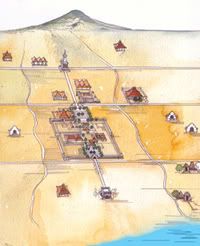
BAYWATCH PECEL - Eating Turi Flower Pecel by Mbah Warno "Anderson"
At first, I was confused by the name of Baywatch pecel owned by Mbah Warno eatery. Passing in my mind, a naughty imagination of a naughty waitress wearing bikini like what Pamela Anderson wore on Baywatch serials or at least it's located on seashore area.
Mbah Warno eatery is located at Kasongan, at the street heading to Sempu Mountain. This place was established 35 years ago and it has a very simple interior. The banner has 30 cm long and 20 cm width which can be easily skipped for those who don't pay attention to it. The interior is totally equipped by simple functional equipments. Only tables and wooden chairs. Behind the table, there're some braziers which always produce smokes. A peculiar position which accidentally designed like that because kitchen in javanese concept is always put at the back of the house but Mbah Warno put his kitchen in front of his eatery after the earthquake accident and he simply said due to the financial constraint he did it.
Mbah Warno serves main menu which is pecel accompanied by some meals starting from fried ell, bacem tofu, lele and mangut ell (ell with coconut milk and chili) and fried noodles. Yogyes ordered everything to taste all Mbah warno culinaries.
During the time of waiting, my mind flew to track down the origin of pecel which is as little known as soto. Many regions in Java have their own pecel with their own characteristic such as Madiun, Blitar, Madura, Slawi and etc. But for at least, a dutch historian enlighted with the fact when Ki Ageng Pamenahan undertook Sultan Hadiwijaya's instruction to proceed to a jungle named Alas Mentaok (now, Kota gede), his groups were welcomed by the opak river-side inhabitants and then they're given some foods including pecel.
My reverie was suddenly cut by the arrival of my pecel and some other meals on the table. A portion of pecel, fried lele and bacem tofu somehow challenged me to eat them as soon as possible. There are four kinds of vegetables which are spinach, papaya leaves, Turi flower (Sesbania grandiflora) and poured by nut sauce which is so yummy. We’ll have sweet flavor from nut sauce and bitter flavor from Turi flower making an unexplainable delicious mixture.
Pecel with Turi flower is the symbol of Ndeso pecel. In this age, it's hardly ever seen a pecel seller packages a kind of it. It's deemed that Turi flower has the benefits of alleviating high body temperature and headache. No wonder, some javanese, indian and Suriname (their ancestor is still javanese though, LOL) still consume young Turi flower as their vegetable.
Pecel will be more delicious by adding with fried lele or Bacem tofu. This lele is fried until very dry so that it's really crispy when you have a bite. And bacem tofu is quite big so you can eat it by combining with some small chilies. Apart from it, you can also have fried ell that has two different sizes and also you can have fried noodles and mangut ell for those who think that spicy is the best one. Smoke from brazier also adds more sensation to this place.
I don't know whether it's caused by my full stomach or effect of Turi flower, after eating, my head was way much smartier than usual. During the small conversation with Mbah Wartno and his assistant, i suddenly understood why pecel at this place is called Baywatch pecel. Apparently, Mbah Warno and his assistants always wear clothes called Kutang. These clothes are really comfortable to wear in the hot and dry weather of Kasongan village, Bantul.
Even though, many people sell pecel everywhere, Baywatch pecel still offers something new for you. A great combination of delish foods, strong village ambiance and hospitality of Mbah Warno "Anderson".







 've Enjoyed Mrs. brongkos Warung Ijo Padmo under Bridge Krasak, Tempel, Sleman? Well, here it is! Was secretly brongkos Warung Ijo Padmo Mom has known since 1950. So, it's almost 60 years this shop serves brongkos lovers and remains legendary. Great is not it?
've Enjoyed Mrs. brongkos Warung Ijo Padmo under Bridge Krasak, Tempel, Sleman? Well, here it is! Was secretly brongkos Warung Ijo Padmo Mom has known since 1950. So, it's almost 60 years this shop serves brongkos lovers and remains legendary. Great is not it?







 Bledug Kuwu is one of tourist attractions in Wirosari area in Grobogan Region, Purwodadi, Central Java. Bledug Kuwu is a local name for something that burst in pool. This is rather strange pool that far from volcano. The vapor burst came from carbon dioxide release. The temperature is mild. Visitors might experience a stunning natural occurrence of small, frequent bursts from mud crate with a sound resembling a mount eruption. This natural phenomenon is resulted from geothermal motion inside the earth bed. Witness said that a big burst could even create small quakes that quiver the area.
Bledug Kuwu is one of tourist attractions in Wirosari area in Grobogan Region, Purwodadi, Central Java. Bledug Kuwu is a local name for something that burst in pool. This is rather strange pool that far from volcano. The vapor burst came from carbon dioxide release. The temperature is mild. Visitors might experience a stunning natural occurrence of small, frequent bursts from mud crate with a sound resembling a mount eruption. This natural phenomenon is resulted from geothermal motion inside the earth bed. Witness said that a big burst could even create small quakes that quiver the area.



